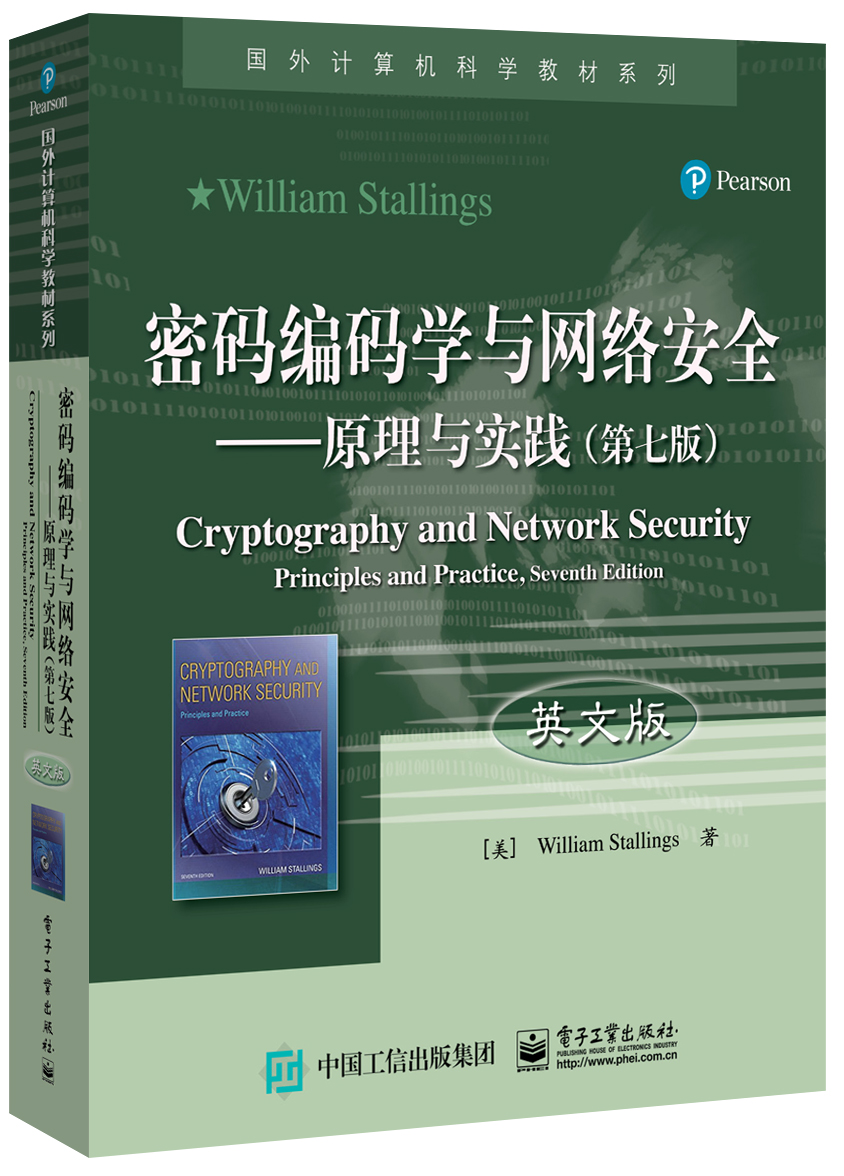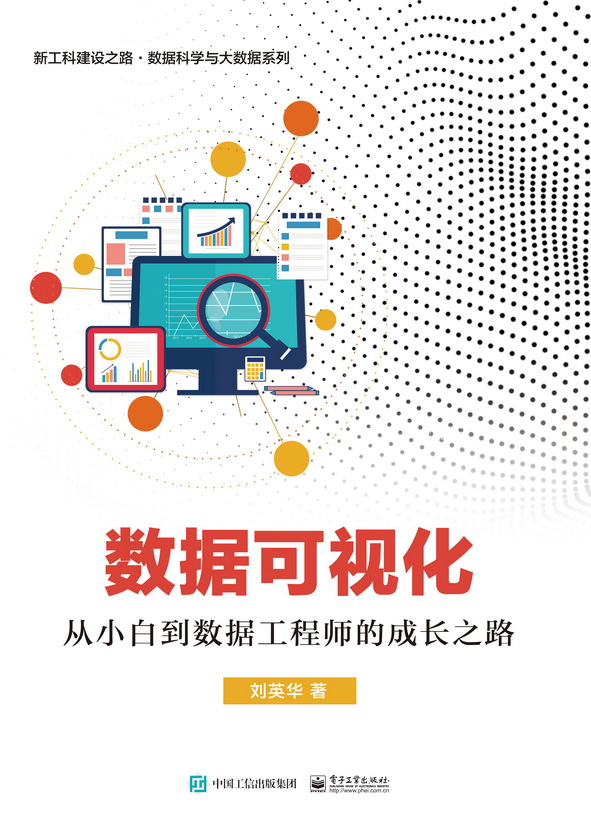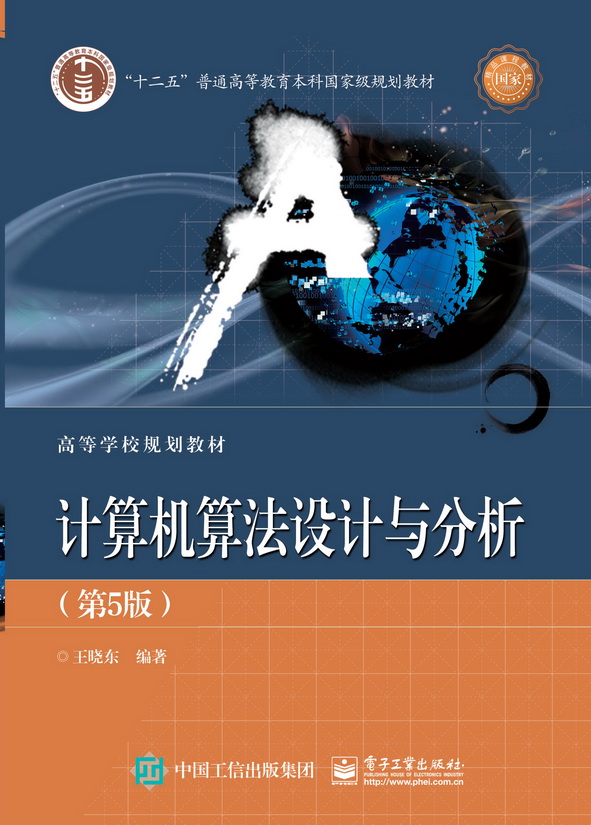密码编码学与网络安全——原理与实践(第七版)(英文版)
丛 书 名:
国外计算机科学教材系列
作 译 者:(美)William Stallings(威廉.斯托林斯)
出 版 日 期:2017-06-01
书 代 号:G0313180
I S B N:9787121313189
图书简介:
本书系统地介绍了密码编码学与网络安全的基本原理和应用技术。纸质教材分为六部分:背景知识部分介绍计算机与网络安全的概念、数论;对称密码部分讨论古典加密技术、分组加密和数据加密标准、有限域、高级加密标准、分组加密操作、随机位生成和流密码;非对称密码部分讨论公钥加密和RSA、其他公钥加密体制;密码编码数据完整性算法部分讨论哈希函数、消息认证编码、数字签名;互信部分讨论密钥管理与分发、用户鉴别;网络和互联网安全部分讨论网络访问控制和云安全、传输层安全、无线网络安全、电子邮件安全、IP安全。联机内容分为两部分:系统安全部分讨论恶意软件、入侵者、防火墙;法律和道德问题部分讨论与计算机和网络安全相关的法律与道德问题。与第六版相比,书的章节组织基本不变,但增加了许多新内容,如数论、格式保留加密、真随机数生成器、云安全、传输层安全、移动设备安全等。
定价 98.0
您的专属联系人更多
联系人:马老师
电话:4557
邮箱:malan@phei.com
-
配 套 资 源图书特别说明:由于成本考虑,本书不作为参考书赠送。如果确有授课教材选用的需求,可将详细情况发送给本书专属联系人,我们将进一步沟通并酌情处理。
本书资源
本书暂无资源会员上传本书资源
-
图 书 内 容
内容简介
本书系统地介绍了密码编码学与网络安全的基本原理和应用技术。纸质教材分为六部分:背景知识部分介绍计算机与网络安全的概念、数论;对称密码部分讨论古典加密技术、分组加密和数据加密标准、有限域、高级加密标准、分组加密操作、随机位生成和流密码;非对称密码部分讨论公钥加密和RSA、其他公钥加密体制;密码编码数据完整性算法部分讨论哈希函数、消息认证编码、数字签名;互信部分讨论密钥管理与分发、用户鉴别;网络和互联网安全部分讨论网络访问控制和云安全、传输层安全、无线网络安全、电子邮件安全、IP安全。联机内容分为两部分:系统安全部分讨论恶意软件、入侵者、防火墙;法律和道德问题部分讨论与计算机和网络安全相关的法律与道德问题。与第六版相比,书的章节组织基本不变,但增加了许多新内容,如数论、格式保留加密、真随机数生成器、云安全、传输层安全、移动设备安全等。图书详情
ISBN:9787121313189开 本:16开页 数:768字 数:1182.0本书目录
Part One: Background 1 Chapter 1 Computer and Network Security Concepts 1 1.1 Computer Security Concepts 3 1.2 The OSI Security Architecture 8 1.3 Security Attacks 9 1.4 Security Services 11 1.5 Security Mechanisms 14 1.6 Fundamental Security Design Principles 16 1.7 Attack Surfaces and Attack Trees 19 1.8 A Model for Network Security 23 1.9 Standards 25 1.10 Key Terms, Review Questions, and Problems 26 Chapter 2 Introduction to Number Theory 28 2.1 Divisibility and the Division Algorithm 29 2.2 The Euclidean Algorithm 31 2.3 Modular Arithmetic 35 2.4 Prime Numbers 43 2.5 Fermat’s and Euler’s Theorems 46 2.6 Testing for Primality 50 2.7 The Chinese Remainder Theorem 53 2.8 Discrete Logarithms 55 2.9 Key Terms, Review Questions, and Problems 60 Appendix 2A The Meaning of Mod 64 Part Two: Symmetric Ciphers 67 Chapter 3 Classical Encryption Techniques 67 3.1 Symmetric Cipher Model 68 3.2 Substitution Techniques 74 3.3 Transposition Techniques 89 3.4 Rotor Machines 90 3.5 Steganography 92 3.6 Key Terms, Review Questions, and Problems 94 Chapter 4 Block Ciphers and the Data Encryption Standard 100 4.1 Traditional Block Cipher Structure 101 4.2 The Data Encryption Standard 111 4.3 A DES Example 113 4.4 The Strength of DES 116 4.5 Block Cipher Design Principles 117 4.6 Key Terms, Review Questions, and Problems 119 Chapter 5 Finite Fields 123 5.1 Groups 125 5.2 Rings 127 5.3 Fields 128 5.4 Finite Fields of the Form GF(p) 129 5.5 Polynomial Arithmetic 133 5.6 Finite Fields of the Form GF(2n) 139 5.7 Key Terms, Review Questions, and Problems 151 Chapter 6 Advanced Encryption Standard 153 6.1 Finite Field Arithmetic 154 6.2 AES Structure 156 6.3 AES Transformation Functions 161 6.4 AES Key Expansion 172 6.5 An AES Example 175 6.6 AES Implementation 179 6.7 Key Terms, Review Questions, and Problems 184 Appendix 6A Polynomials with Coefficients in GF(28) 185 Chapter 7 Block Cipher Operation 189 7.1 Multiple Encryption and Triple DES 190 7.2 Electronic Codebook 195 7.3 Cipher Block Chaining Mode 198 7.4 Cipher Feedback Mode 200 7.5 Output Feedback Mode 202 7.6 Counter Mode 204 7.7 XTS-AES Mode for Block-Oriented Storage Devices 206 7.8 Format-Preserving Encryption 213 7.9 Key Terms, Review Questions, and Problems 227 Chapter 8 Random Bit Generation and Stream Ciphers 232 8.1 Principles of Pseudorandom Number Generation 234 8.2 Pseudorandom Number Generators 240 8.3 Pseudorandom Number Generation Using a Block Cipher 243 8.4 Stream Ciphers 249 8.5 RC4 251 8.6 True Random Number Generators 253 8.7 Key Terms, Review Questions, and Problems 262 Part Three: Asymmetric Ciphers 265 Chapter 9 Public-Key Cryptography and RSA 265 9.1 Principles of Public-Key Cryptosystems 267 9.2 The RSA Algorithm 276 9.3 Key Terms, Review Questions, and Problems 290 Chapter 10 Other Public-Key Cryptosystems 295 10.1 Diffie-Hellman Key Exchange 296 10.2 Elgamal Cryptographic System 300 10.3 Elliptic Curve Arithmetic 303 10.4 Elliptic Curve Cryptography 312 10.5 Pseudorandom Number Generation Based on an Asymmetric Cipher 316 10.6 Key Terms, Review Questions, and Problems 318 Part Four: Cryptographic Data Integrity Algorithms 321 Chapter 11 Cryptographic Hash Functions 321 11.1 Applications of Cryptographic Hash Functions 323 11.2 Two Simple Hash Functions 328 11.3 Requirements and Security 330 11.4 Hash Functions Based on Cipher Block Chaining 336 11.5 Secure Hash Algorithm (SHA) 337 11.6 SHA-3 347 11.7 Key Terms, Review Questions, and Problems 359 Chapter 12 Message Authentication Codes 363 12.1 Message Authentication Requirements 364 12.2 Message Authentication Functions 365 12.3 Requirements for Message Authentication Codes 373 12.4 Security of MACs 375 12.5 MACs Based on Hash Functions: HMAC 376 12.6 MACs Based on Block Ciphers: DAA and CMAC 381 12.7 Authenticated Encryption: CCM and GCM 384 12.8 Key Wrapping 390 12.9 Pseudorandom Number Generation Using Hash Functions and MACs 395 12.10 Key Terms, Review Questions, and Problems 398 Chapter 13 Digital Signatures 401 13.1 Digital Signatures 403 13.2 Elgamal Digital Signature Scheme 406 13.3 Schnorr Digital Signature Scheme 407 13.4 NIST Digital Signature Algorithm 408 13.5 Elliptic Curve Digital Signature Algorithm 412 13.6 RSA-PSS Digital Signature Algorithm 415 13.7 Key Terms, Review Questions, and Problems 420 Part Five: Mutual Trust 423 Chapter 14 Key Management and Distribution 423 14.1 Symmetric Key Distribution Using Symmetric Encryption 424 14.2 Symmetric Key Distribution Using Asymmetric Encryption 433 14.3 Distribution of Public Keys 436 14.4 X.509 Certificates 441 14.5 Public-Key Infrastructure 449 14.6 Key Terms, Review Questions, and Problems 451 Chapter 15 User Authentication 455 15.1 Remote User-Authentication Principles 456 15.2 Remote User-Authentication Using Symmetric Encryption 460 15.3 Kerberos 464 15.4 Remote User-Authentication Using Asymmetric Encryption 482 15.5 Federated Identity Management 484 15.6 Personal Identity Verification 490 15.7 Key Terms, Review Questions, and Problems 497 Part Six: Network And Internet Security 501 Chapter 16 Network Access Control and Cloud Security 501 16.1 Network Access Control 502 16.2 Extensible Authentication Protocol 505 16.3 IEEE 802.1X Port-Based Network Access Control 509 16.4 Cloud Computing 511 16.5 Cloud Security Risks and Countermeasures 517 16.6 Data Protection in the Cloud 519 16.7 Cloud Security as a Service 523 16.8 Addressing Cloud Computing Security Concerns 526 16.9 Key Terms, Review Questions, and Problems 527 Chapter 17 Transport-Level Security 528 17.1 Web Security Considerations 529 17.2 Transport Layer Security 531 17.3 HTTPS 548 17.4 Secure Shell (SSH) 549 17.5 Key Terms, Review Questions, and Problems 561 Chapter 18 Wireless Network Security 563 18.1 Wireless Security 564 18.2 Mobile Device Security 567 18.3 IEEE 802.11 Wireless LAN Overview 571 18.4 IEEE 802.11i Wireless LAN Security 577 18.5 Key Terms, Review Questions, and Problems 592 Chapter 19 Electronic Mail Security 594 19.1 Internet Mail Architecture 595 19.2 Email Formats 599 19.3 Email Threats and Comprehensive Email Security 607 19.4 S/MIME 609 19.5 Pretty Good Privacy 620 19.6 DNSSEC 621 19.7 DNS-Based Authentication of Named Entities 625 19.8 Sender Policy Framework 627 19.9 DomainKeys Identified Mail 630 19.10 Domain-Based Message Authentication, Reporting, and Conformance 636 19.11 Key Terms, Review Questions, and Problems 641 Chapter 20 IP Security 643 20.1 IP Security Overview 644 20.2 IP Security Policy 650 20.3 Encapsulating Security Payload 655 20.4 Combining Security Associations 663 20.5 Internet Key Exchange 666 20.6 Cryptographic Suites 674 20.7 Key Terms, Review Questions, and Problems 676 APPENDICES 678 Appendix A Projects for Teaching Cryptography and Network Security 678 A.1 Sage Computer Algebra Projects 679 A.2 Hacking Project 680 A.3 Block Cipher Projects 681 A.4 Laboratory Exercises 681 A.5 Research Projects 681 A.6 Programming Projects 682 A.7 Practical Security Assessments 682 A.8 Firewall Projects 683 A.9 Case Studies 683 A.10 Writing Assignments 683 A.11 Reading/Report Assignments 684 A.12 Discussion Topics 684 Appendix B Sage Examples 685 B.1 Linear Algebra and Matrix Functionality 686 B.2 Chapter 2: Number Theory 687 B.3 Chapter 3: Classical Encryption 692 B.4 Chapter 4: Block Ciphers and the Data Encryption Standard 695 B.5 Chapter 5: Basic Concepts in Number Theory and Finite Fields 699 B.6 Chapter 6: Advanced Encryption Standard 706 B.7 Chapter 8: Pseudorandom Number Generation and Stream Ciphers 711 B.8 Chapter 9: Public-Key Cryptography and RSA 713 B.9 Chapter 10: Other Public-Key Cryptosystems 716 B.10 Chapter 11: Cryptographic Hash Functions 721 B.11 Chapter 13: Digital Signatures 723 References 726 Credits 735 Index 736 Online Chapters and Appendices1 Part Seven: System Security Chapter 21 Malicious Software 21.1 Types of Malicious Software (Malware) 21.2 Advanced Persistent Threat 21.3 Propagation—Infected Content—Viruses 21.4 Propagation—Vulnerability Exploit—Worms 21.5 Propagation—Social Engineering—Spam E-mail, Trojans 21.6 Payload—System Corruption 21.7 Payload—Attack Agent—Zombie, Bots 21.8 Payload—Information Theft—Keyloggers, Phishing, Spyware 21.9 Payload—Stealthing—Backdoors, Rootkits 21.10 Countermeasures 21.11 Distributed Denial of Service Attacks 21.12 References 21.13 Key Terms, Review Questions, and Problems Chapter 22 Intruders 22.1 Intruders 22.2 Intrusion Detection 22.3 Password Management 22.4 References 22.5 Key Terms, Review Questions, and Problems Chapter 23 Firewalls 23.1 The Need for Firewalls 23.2 Firewall Characteristics and Access Policy 23.3 Types of Firewalls 23.4 Firewall Basing 23.5 Firewall Location and Configurations 23.6 References 23.7 Key Terms, Review Questions, and Problems Part EIGHT: Legal And Ethical Issues Chapter 24 Legal and Ethical Aspects 24.1 Cybercrime and Computer Crime 24.2 Intellectual Property 24.3 Privacy 24.4 Ethical Issues 24.5 Recommended Reading 24.6 References 24.7 Key Terms, Review Questions, and Problems 24.A Information Privacy Appendix C Sage Exercises Appendix D Standards and Standard-Setting Organizations Appendix E Basic Concepts from Linear Algebra Appendix F Measures of Secrecy and Security Appendix G Simplified DES Appendix H Evaluation Criteria for AES Appendix I Simplified AES Appendix J The Knapsack Algorithm Appendix K Proof of the Digital Signature Algorithm Appendix L TCP/IP and OSI Appendix M Java Cryptographic APIs Appendix N MD5 Hash Function Appendix O Data Compression Using ZIP Appendix P PGP Appendix Q The International Reference Alphabet Appendix R Proof of the RSA Algorithm Appendix S Data Encryption Standard Appendix T Kerberos Encryption Techniques Appendix U Mathematical Basis of the Birthday Attack Appendix V Evaluation Criteria for SHA-3 Appendix W The Complexity of Algorithms Appendix X Radix-64 Conversion Appendix Y The Base Rate Fallacy Glossary展开前 言
Preface In the four years since the sixth edition of this book was published, the field has seen continued innovations and improvements. In this new edition, I try to capture these changes while maintaining a broad and comprehensive coverage of the entire field. To begin this process of revision, the sixth edition of this book was extensively reviewed by a number of professors who teach the subject and by professionals working in the field. The result is that, in many places, the narrative has been clarified and tightened, and illustrations have been improved. Beyond these refinements to improve pedagogy and user-friendliness, there have been substantive changes throughout the book. Roughly the same chapter organization has been retained, but much of the material has been revised and new material has been added. The most noteworthy changes are as follows: ■■ Fundamental security design principles: Chapter 1 includes a new section discussing the security design principles listed as fundamental by the National Centers of Academic Excellence in Information Assurance/Cyber Defense, which is jointly sponsored by the U.S. National Security Agency and the U.S. Department of Homeland Security. ■■ Attack surfaces and attack trees: Chapter 1 includes a new section describing these two concepts, which are useful in evaluating and classifying security threats. ■■ Number theory coverage: The material on number theory has been consolidated into a single chapter, Chapter 2. This makes for a convenient reference. The relevant portions of Chapter 2 can be assigned as needed. ■■ Finite fields: The chapter on finite fields has been revised and expanded with additional text and new figures to enhance understanding. ■■ Format-preserving encryption: This relatively new mode of encryption is enjoying increasing commercial success. A new section in Chapter 7 covers this method. ■■ Conditioning and health testing for true random number generators: Chapter 8 now provides coverage of these important topics. ■■ User authentication model: Chapter 15 includes a new description of a general model for user authentication, which helps to unify the discussion of the various approaches to user authentication. ■■ Cloud security: The material on cloud security in Chapter 16 has been updated and expanded to reflect its importance and recent developments. ■■ Transport Layer Security (TLS): The treatment of TLS in Chapter 17 has been updated, reorganized to improve clarity, and now includes a discussion of the new TLS version 1.3. ■■ Email Security: Chapter 19 has been completely rewritten to provide a comprehensive and up-to-date discussion of email security. It includes: —— New: discussion of email threats and a comprehensive approach to email security. —— New: discussion of STARTTLS, which provides confidentiality and authentication for SMTP. —— Revised: treatment of S/MIME has been updated to reflect the latest version 3.2. —— New: discussion of DNSSEC and its role in supporting email security. —— New: discussion of DNS-based Authentication of Named Entities (DANE) and the use of this approach to enhance security for certificate use in SMTP and S/MIME. —— New: discussion of Sender Policy Framework (SPF), which is the standardized way for a sending domain to identify and assert the mail senders for a given domain. —— Revised: discussion of DomainKeys Identified Mail (DKIM) has been revised. —— New: discussion of Domain-based Message Authentication, Reporting, and Conformance (DMARC) allows email senders to specify policy on how their mail should be handled, the types of reports that receivers can send back, and the frequency those reports should be sent. It is the purpose of this book to provide a practical survey of both the principles and practice of cryptography and network security. In the first part of the book, the basic issues to be addressed by a network security capability are explored by providing a tutorial and survey of cryptography and network security technology. The latter part of the book deals with the practice of network security: practical applications that have been implemented and are in use to provide network security. The subject, and therefore this book, draws on a variety of disciplines. In particular, it is impossible to appreciate the significance of some of the techniques discussed in this book without a basic understanding of number theory and some results from probability theory. Nevertheless, an attempt has been made to make the book self-contained. The book not only presents the basic mathematical results that are needed but provides the reader with an intuitive understanding of those results. Such background material is introduced as needed. This approach helps to motivate the material that is introduced, and the author considers this preferable to simply presenting all of the mathematical material in a lump at the beginning of the book. The book is intended for both academic and professional audiences. As a textbook, it is intended as a one-semester undergraduate course in cryptography and network security for computer science, computer engineering, and electrical engineering majors. The changes to this edition are intended to provide support of the ACM/IEEE Computer Science Curricula 2013 (CS2013). CS2013 adds Information Assurance and Security (IAS) to the curriculum recommendation as one of the Knowledge Areas in the Computer Science Body of Knowledge. The document states that IAS is now part of the curriculum recommendation because of the critical role of IAS in computer science education. CS2013 divides all course work into three categories: Core-Tier 1 (all topics should be included in the curriculum), Core-Tier-2 (all or almost all topics should be included), and elective (desirable to provide breadth and depth). In the IAS area, CS2013 recommends topics in Fundamental Concepts and Network Security in Tier 1 and Tier 2, and Cryptography topics as elective. This text covers virtually all of the topics listed by CS2013 in these three categories. The book also serves as a basic reference volume and is suitable for self-study. The book is divided into eight parts. ■■ Background ■■ Symmetric Ciphers ■■ Asymmetric Ciphers ■■ Cryptographic Data Integrity Algorithms ■■ Mutual Trust ■■ Network and Internet Security ■■ System Security ■■ Legal and Ethical Issues The book includes a number of pedagogic features, including the use of the computer algebra system Sage and numerous figures and tables to clarify the discussions. Each chapter includes a list of key words, review questions, homework problems, and suggestions for further reading. The book also includes an extensive glossary, a list of frequently used acronyms, and a bibliography. In addition, a test bank is available to instructors. The major goal of this text is to make it as effective a teaching tool for this exciting and fast- moving subject as possible. This goal is reflected both in the structure of the book and in the supporting material. The text is accompanied by the following supplementary material that will aid the instructor: ■■ Solutions manual: Solutions to all end-of-chapter Review Questions and Problems. ■■ Projects manual: Suggested project assignments for all of the project categories listed below. ■■ PowerPoint slides: A set of slides covering all chapters, suitable for use in lecturing. ■■ PDF files: Reproductions of all figures and tables from the book. ■■ Test bank: A chapter-by-chapter set of questions with a separate file of answers. ■■ Sample syllabuses: The text contains more material than can be conveniently covered in one semester. Accordingly, instructors are provided with several sample syllabuses that guide the use of the text within limited time. These samples are based on real- world experience by professors with the fifth edition. All of these support materials are available at the Instructor Resource Center (IRC) for this textbook, which can be reached through the publisher’s Web site www.pearsonhighered .com/stallings or by clicking on the link labeled Pearson Resources for Instructors at this book’s Author Web site at WilliamStallings.com/Cryptography. To gain access to the IRC, please contact your local Pearson sales representative via pearsonhighered.com/educator/ replocator/requestSalesRep.page or call Pearson Faculty Services at 1-800-526-0485. The Author Web site, at WilliamStallings.com/Cryptography (click on Instructor Resources link), includes the following: ■■ Links to Web sites for other courses being taught using this book. ■■ Sign-up information for an Internet mailing list for instructors using this book to exchange information, suggestions, and questions with each other and with the author. Projects and Other Student Exercises For many instructors, an important component of a cryptography or network security course is a project or set of projects by which the student gets hands-on experience to reinforce concepts from the text. This book provides an unparalleled degree of support, including a projects component in the course. The IRC not only includes guidance on how to assign and structure the projects, but also includes a set of project assignments that covers a broad range of topics from the text: ■■ Sage projects: Described in the next section. ■■ Hacking project: Exercise designed to illuminate the key issues in intrusion detection and prevention. ■■ Block cipher projects: A lab that explores the operation of the AES encryption algorithm by tracing its execution, computing one round by hand, and then exploring the various block cipher modes of use. The lab also covers DES. In both cases, an online Java applet is used (or can be downloaded) to execute AES or DES. ■■ Lab exercises: A series of projects that involve programming and experimenting with concepts from the book. ■■ Research projects: A series of research assignments that instruct the student to research a particular topic on the Internet and write a report. ■■ Programming projects: A series of programming projects that cover a broad range of topics and that can be implemented in any suitable language on any platform. ■■ Practical security assessments: A set of exercises to examine current infrastructure and practices of an existing organization. ■■ Firewall projects: A portable network firewall visualization simulator, together with exercises for teaching the fundamentals of firewalls. ■■ Case studies: A set of real-world case studies, including learning objectives, case description, and a series of case discussion questions. ■■ Writing assignments: A set of suggested writing assignments, organized by chapter. ■■ Reading/report assignments: A list of papers in the literature—one for each chapter— that can be assigned for the student to read and then write a short report. This diverse set of projects and other student exercises enables the instructor to use the book as one component in a rich and varied learning experience and to tailor a course plan to meet the specific needs of the instructor and students. See Appendix A in this book for details. One of the most important features of this book is the use of Sage for cryptographic examples and homework assignments. Sage is an open-source, multiplatform, freeware package that implements a very powerful, flexible, and easily learned mathematics and computer algebra system. Unlike competing systems (such as Mathematica, Maple, and MATLAB), there are no licensing agreements or fees involved. Thus, Sage can be made available on computers and networks at school, and students can individually download the software to their own personal computers for use at home. Another advantage of using Sage is that students learn a powerful, flexible tool that can be used for virtually any mathematical application, not just cryptography. The use of Sage can make a significant difference to the teaching of the mathematics of cryptographic algorithms. This book provides a large number of examples of the use of Sage covering many cryptographic concepts in Appendix B, which is included in this book. Appendix C lists exercises in each of these topic areas to enable the student to gain hands-on experience with cryptographic algorithms. This appendix is available to instructors at the IRC for this book. Appendix C includes a section on how to download and get started with Sage, a section on programming with Sage, and exercises that can be assigned to students in the following categories: ■■ Chapter 2—Number Theory and Finite Fields: Euclidean and extended Euclidean algorithms, polynomial arithmetic, GF(24), Euler’s Totient function, Miller–Rabin, factoring, modular exponentiation, discrete logarithm, and Chinese remainder theorem. ■■ Chapter 3—Classical Encryption: Affine ciphers and the Hill cipher. ■■ Chapter 4—Block Ciphers and the Data Encryption Standard: Exercises based on SDES. ■■ Chapter 6—Advanced Encryption Standard: Exercises based on SAES. ■■ Chapter 8—Pseudorandom Number Generation and Stream Ciphers: Blum Blum Shub, linear congruential generator, and ANSI X9.17 PRNG. ■■ Chapter 9—Public-Key Cryptography and RSA: RSA encrypt/decrypt and signing. ■■ Chapter 10—Other Public-Key Cryptosystems: Diffie–Hellman, elliptic curve. ■■ Chapter 11—Cryptographic Hash Functions: Number-theoretic hash function. ■■ Chapter 13—Digital Signatures: DSA. For this new edition, a tremendous amount of original supporting material for students has been made available online, at two Web locations. The Author Web site, at WilliamStallings. com/Cryptography (click on Student Resources link), includes a list of relevant links organized by chapter and an errata sheet for the book. Purchasing this textbook new also grants the reader six months of access to the Companion Website, which includes the following materials: ■■ Online chapters: To limit the size and cost of the book, four chapters of the book are provided in PDF format. This includes three chapters on computer security and one on legal and ethical issues. The chapters are listed in this book’s table of contents. ■■ Online appendices: There are numerous interesting topics that support material found in the text but whose inclusion is not warranted in the printed text. A total of 20 online appendices cover these topics for the interested student. The appendices are listed in this book’s table of contents. ■■ Homework problems and solutions: To aid the student in understanding the material, a separate set of homework problems with solutions are available. ■■ Key papers: A number of papers from the professional literature, many hard to find, are provided for further reading. ■■ Supporting documents: A variety of other useful documents are referenced in the text and provided online. ■■ Sage code: The Sage code from the examples in Appendix B is useful in case the student wants to play around with the examples. To access the Companion Website, follow the instructions for “digital resources for students” found in the front of this book. This new edition has benefited from review by a number of people who gave generously of their time and expertise. The following professors reviewed all or a large part of the manuscript: Hossein Beyzavi (Marymount University), Donald F. Costello (University of Nebraska–Lincoln), James Haralambides (Barry University), Anand Seetharam (California State University at Monterey Bay), Marius C. Silaghi (Florida Institute of Technology), Shambhu Upadhyaya (University at Buffalo), Zhengping Wu (California State University at San Bernardino), Liangliang Xiao (Frostburg State University), Seong-Moo (Sam) Yoo (The University of Alabama in Huntsville), and Hong Zhang (Armstrong State University). Thanks also to the people who provided detailed technical reviews of one or more chapters: Dino M. Amaral, Chris Andrew, Prof. (Dr). C. Annamalai, Andrew Bain, Riccardo Bernardini, Olivier Blazy, Zervopoulou Christina, Maria Christofi, Dhananjoy Dey, Mario Emmanuel, Mike Fikuart, Alexander Fries, Pierpaolo Giacomin, Pedro R. M. Inácio, Daniela Tamy Iwassa, Krzysztof Janowski, Sergey Katsev, Adnan Kilic, Rob Knox, Mina Pourdashty, Yuri Poeluev, Pritesh Prajapati, Venkatesh Ramamoorthy, Andrea Razzini, Rami Rosen, Javier Scodelaro, Jamshid Shokrollahi, Oscar So, and David Tillemans. In addition, I was fortunate to have reviews of individual topics by “subject-area gurus,” including Jesse Walker of Intel (Intel’s Digital Random Number Generator), Russ Housley of Vigil Security (key wrapping), Joan Daemen (AES), Edward F. Schaefer of Santa Clara University (Simplified AES), Tim Mathews, formerly of RSA Laboratories (S/MIME), Alfred Menezes of the University of Waterloo (elliptic curve cryptography), William Sutton, Editor/Publisher of The Cryptogram (classical encryption), Avi Rubin of Johns Hopkins University (number theory), Michael Markowitz of Information Security Corporation (SHA and DSS), Don Davis of IBM Internet Security Systems (Kerberos), Steve Kent of BBN Technologies (X.509), and Phil Zimmerman (PGP). Nikhil Bhargava (IIT Delhi) developed the set of online homework problems and solutions. Dan Shumow of Microsoft and the University of Washington developed all of the Sage examples and assignments in Appendices B and C. Professor Sreekanth Malladi of Dakota State University developed the hacking exercises. Lawrie Brown of the Australian Defence Force Academy provided the AES/DES block cipher projects and the security assessment assignments. Sanjay Rao and Ruben Torres of Purdue University developed the laboratory exercises that appear in the IRC. The following people contributed project assignments that appear in the instructor’s supplement: Henning Schulzrinne (Columbia University); Cetin Kaya Koc (Oregon State University); and David Balenson (Trusted Information Systems and George Washington University). Kim McLaughlin developed the test bank. Finally, I thank the many people responsible for the publication of this book, all of whom did their usual excellent job. This includes the staff at Pearson, particularly my editor Tracy Johnson, program manager Carole Snyder, and production manager Bob Engelhardt. Thanks also to the marketing and sales staffs at Pearson, without whose efforts this book would not be in front of you. About the Author Dr. William Stallings has authored 18 titles, and counting revised editions, over 40 books on computer security, computer networking, and computer architecture. His writings have appeared in numerous publications, including the Proceedings of the IEEE, ACM Computing Reviews, and Cryptologia. He has 13 times received the award for the best Computer Science textbook of the year from the Text and Academic Authors Association. In over 30 years in the field, he has been a technical contributor, technical manager, and an executive with several high-technology firms. He has designed and implemented both TCP/IP-based and OSI-based protocol suites on a variety of computers and operating systems, ranging from microcomputers to mainframes. As a consultant, he has advised government agencies, computer and software vendors, and major users on the design, selection, and use of networking software and products. He created and maintains the Computer Science Student Resource Site at ComputerScienceStudent.com. This site provides documents and links on a variety of subjects of general interest to computer science students (and professionals). He is a member of the editorial board of Cryptologia, a scholarly journal devoted to all aspects of cryptology. Dr. Stallings holds a PhD from MIT in computer science and a BS from Notre Dame in electrical engineering.展开作者简介
本书暂无作者简介 -
样 章 试 读
-
图 书 评 价 我要评论









